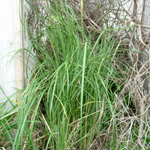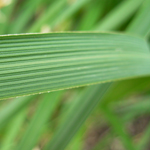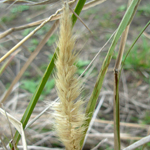African feather grass
African feather grass is an erect, perennial grass that can grow to a height of 2 metres.
Scientific name:
- Pennisetum macrourum Trin
Common name:
- African feather grass
Plant status
Catchment management authority boundaries
Regionally prohibited in the Mallee, Wimmera, North Central, Corangamite, Goulburn Broken, North East, West Gippsland, East Gippsland, Port Phillip and Western Port catchments.
Regionally controlled in the Glenelg Hopkins catchments.
Restricted in no areas in Victoria.
Plant biology

Appearance
Herbaceous plant - Graminoid (grass, sedge or rush)
Description
African feather grass is an erect, perennial grass that can grow to a height of 2 metres.
Stems
Stems are erect, cylindrical, unbranched and hairless. They grow to a length of 2m with several stems emerging from a single crown.

Leaves
Leaves are light green and strongly ribbed on the upper surface. They are a darker green underneath and sometimes purplish along the edges and tips.
Leaves grow up to 1.2m long, 1.2cm wide, are hairless or with a few hairs near base. They have fine serrations on the ribs, are slightly curled, and are sometimes drooping with up to 5 leaves per stem.
Sheaths have sparse covering of hairs. Emerging leaves are in-rolled which later become flattened but tips remain in-rolled.
The ligule is fringed with hairs 0.5 to 1.5mm long.
Flowers
Flowers are purplish, yellow or brown with an erect or drooping, spike-like panicle which is 8 to 30cm in length, 1 to 2cm diameter and formed at the ends of stems.
The flowers have numerous florets 5 to 7mm long, surrounded by feather-like serrated bristles 1 to 1.5cm in length.
Fruit
No fruit.
Roots
African feather grass has an extensive fibrous root system with stout rhizomes to 7cm diameter and 2m length.
Growth and lifecycle
Method of reproduction and dispersal
The seeds of African feather grass are bristled and easily cling to clothing, material and to the wool and hair of animals.
Seeds are spread readily by water and infestations are often found along streams. Plants growing on stream banks are capable of dispersing seed more than one kilometre downstream.
Seeds may also be dispersed by wind.
Rhizomes of the plant may be spread by cultivation equipment, road graders and other machinery. Once established, patches increase in size by lateral growth of roots and rhizomes.
Rate of growth and spread
African feather grass is an aggressive invader and often competes and displaces riparian vegetation.
Seedbank propagule persistence
Each plant is capable of producing more than 2000 seeds annually. In dense patches, over 100,000 seeds can be produced per square metre, per year but in most years the number is far less because many florets are sterile.
Up to 80 per cent of the seed from African feather grass is viable. However, the majority of seeds are not long lived in the soil — surviving for less than 5 years.
Preferred habitat
African feather grass prefers sub humid, warm, temperate regions where it grows on stream banks, roadsides, poorer pastures and often in areas of sandy soil or with an annual rainfall above 600mm.
It invades lowland grassland, grassy woodland, riparian vegetation and freshwater wetlands.
African feather grass tolerates a wide range of growing conditions. It can withstand water-logging and established plants are relatively drought resistant. However it requires full sunlight and does not grow well in shady bushland areas.
Distribution
In Victoria, African feather grass is mainly confined to the area around Casterton and the Glenelg River, with satellite infestations at Macarthur, Penshurst and Coalville near Moe in Gippsland. Scattered plants have also been found on roadsides near Geelong.
Growth calendar
The icons on the following table represent the times of year for flowering, seeding, germination, the dormancy period of African feather grass and also the optimum time for treatment.
| Jan | Feb | Mar | Apr | May | Jun | Jul | Aug | Sep | Oct | Nov | Dec | |
|---|---|---|---|---|---|---|---|---|---|---|---|---|
| Flowering | ||||||||||||
| Seeding | ||||||||||||
| Germination | ||||||||||||
| Dormancy | ||||||||||||
| Treatment |
Impact
Impact on ecosystems and waterways
African feather grass has the potential to suppress under-storey regeneration in grassy woodland areas.
Dense clumps of this weed can eliminate all other plant communities and result in a major displacement of grass species. Infestations may also present a fire hazard.
Large plants and infestations are capable of blocking waterways and channels by trapping silt and debris. They may also prevent physical access to streams and waterways.
Agricultural and economic impacts
African feather grass is predominantly a pasture weed and can dominate in pastures, seriously impacting on grazing potential.
Once the plant is established, improving the pasture alone does not control the weed. Infested areas become unusable for grazing without significant control activities.
The bristled seeds of African feather grass easily cling to the wool and hair of animals.
Social value and health impacts
Dense infestations of African feather grass may present a fire hazard and are capable of preventing physical access to streams and waterways.
Management
Prescribed measures for the control of noxious weeds:
- application of a registered herbicide
- cultivation
- physical removal
Read about prescribed measures for the control of noxious weeds.
Other management techniques
Changes in land use practices and spread prevention may also support African feather grass management after implementing the prescribed measures.